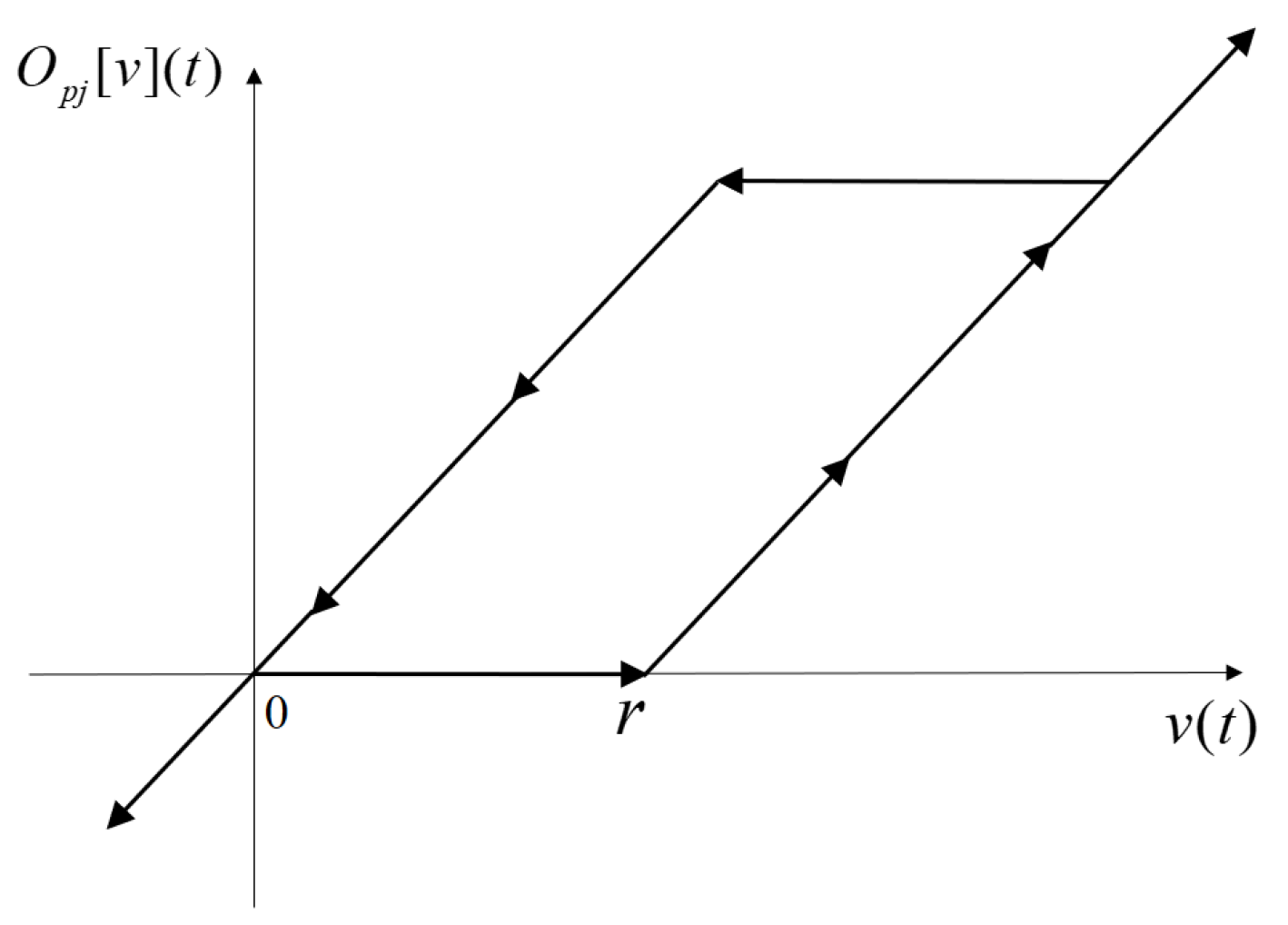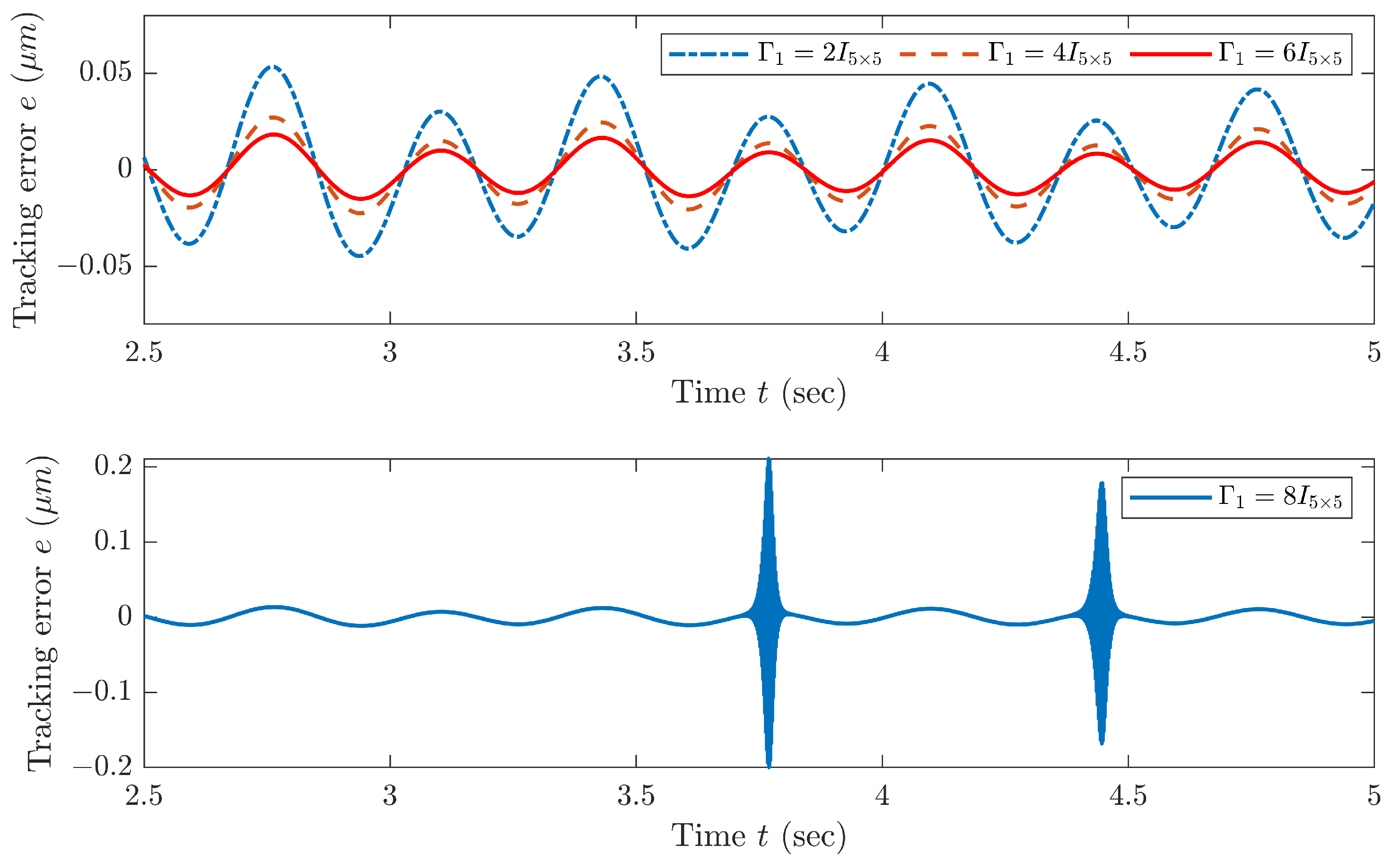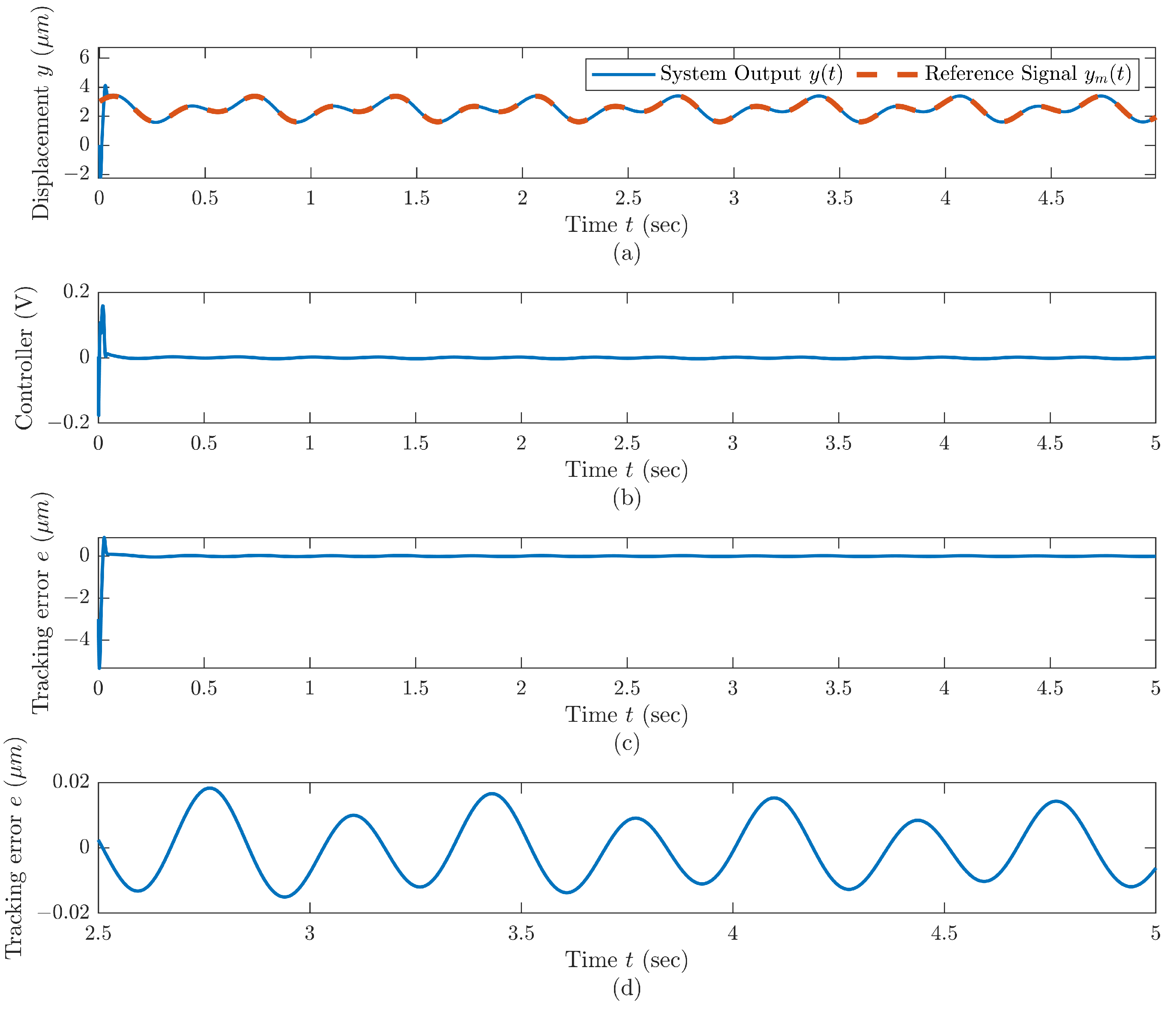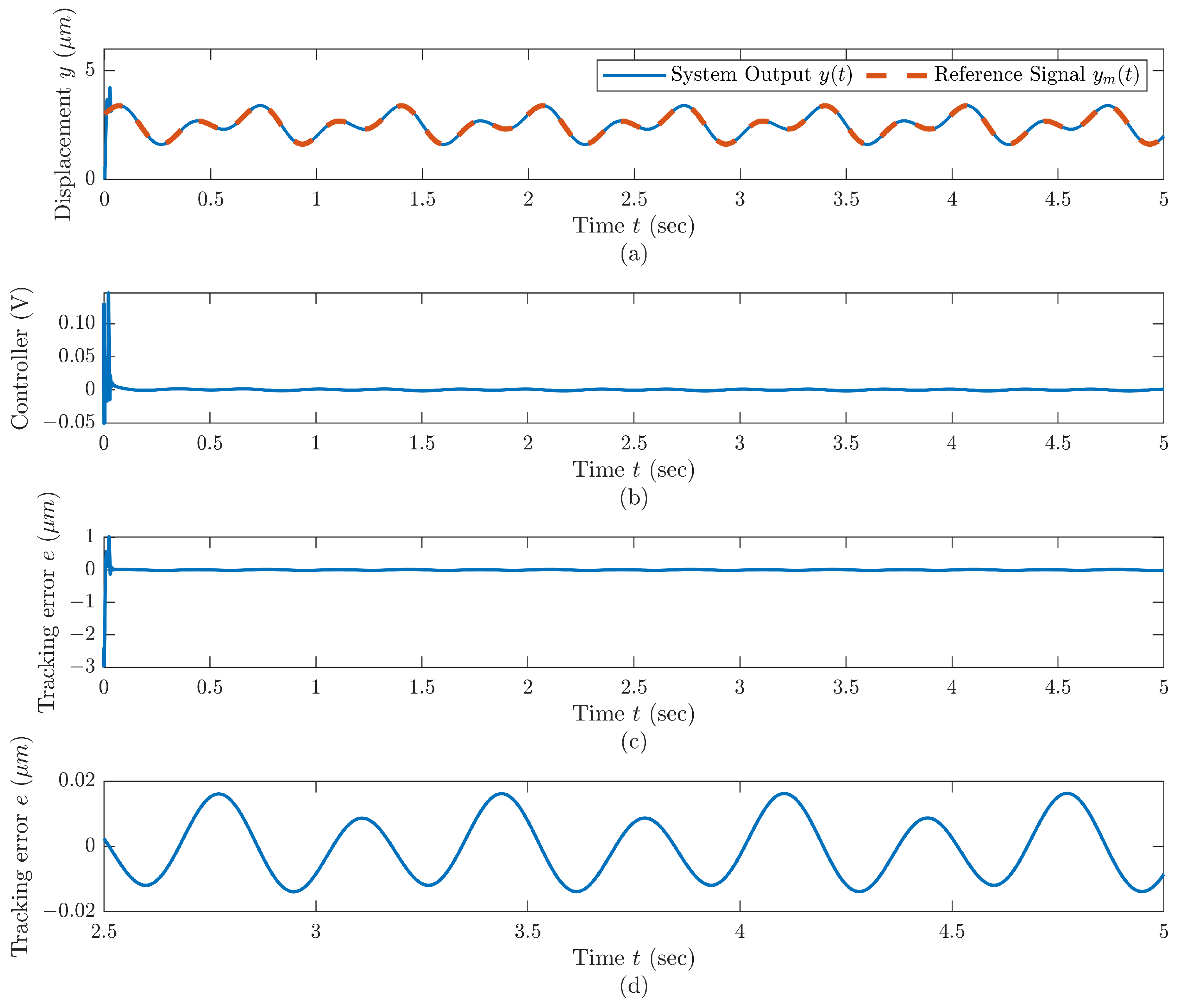Adaptive Tracking Control Schemes for Fuzzy Approximation-Based Noncanonical Nonlinear Systems with Hysteresis Inputs
Abstract
:1. Introduction
- (1)
- For a class of noncanonical nonlinear systems cascaded by a hysteresis operator with uncertain parameters, we use a fuzzy logic system to deal with the technical issues caused by the unknown nonlinear part for reducing the influence of the unknown nonlinear factors on the control system and develop a new control scheme based on Lyapunov and feedback linearization techniques, such that the hysteresis disturbance terms possessed within the system are compensated to obtain the desired output tracking performance.
- (2)
- A more general gradient-based adaptive parameter updating with integrated switching -modification compensation is developed, which can avoid the controller singularity and robustify the bounded disturbances generated by the hysteresis decomposition. Our scheme based on fuzzy approximation can solve the output tracking problem of noncanonical nonlinear systems with unknown hysteresis inputs. We verify the output tracking performance of our scheme through the simulation results and demonstrate the robustness of our scheme to disturbance.
- (3)
- We have performed the strict signal boundedness proof and system stability analysis for both proposed control schemes, which ensures the reliability of the proposed control schemes.
- ;
- has the following form:
- , denoting signal norm, has the following form:
2. Problem Formulation and Preliminaries
2.1. Plant Formulation
2.2. Noncanonical Fuzzy Approximation-Based Model
2.3. Control Objective
3. Relative Degree Norms and the Stability of Zero Dynamics Subsystem
3.1. System Relative Degree Norms
3.2. Dynamics Subsystem
4. Control Design for Fuzzy Approximation-Based System with Relative Degree One
4.1. Plant Description and Nominal Control Scheme
4.2. Lyapunov-Based Adaptive Control Scheme
4.2.1. Adaptive Update Law for
4.2.2. Performance Analysis
4.3. Gradient-Based Adaptive Control Scheme
4.3.1. Adaptive Update Law for
4.3.2. Properties of Estimated Parameters and Performance Analysis
5. Simulation Results
5.1. Simulation Results of Lyapunov-Based Control Scheme
5.2. Simulation Results of Gradient-Based Control Scheme
6. Conclusions
Author Contributions
Funding
Institutional Review Board Statement
Informed Consent Statement
Data Availability Statement
Acknowledgments
Conflicts of Interest
Appendix A
References
- Jin, H.; Gao, X.; Ren, K.; Liu, J.; Qiao, L.; Liu, M.; Chen, W.; He, Y.; Dong, S.; Xu, Z.; et al. Review on Piezoelectric Actuators Based on High-Performance Piezoelectric Materials. IEEE Trans. Ultrason. Ferroelectr. Freq. Control 2022, 69, 3057–3069. [Google Scholar] [CrossRef] [PubMed]
- Chen, J.; Peng, G.; Hu, H.; Ning, J. Dynamic Hysteresis Model and Control Methodology for Force Output Using Piezoelectric Actuator Driving. IEEE Access 2020, 8, 205136–205147. [Google Scholar] [CrossRef]
- Feng, Y.; Li, Y. System Identification of Micro Piezoelectric Actuators via Rate-Dependent Prandtl-Ishlinskii Hysteresis Model Based on a Modified PSO Algorithm. IEEE Trans. Nanotechnol. 2021, 20, 205–214. [Google Scholar] [CrossRef]
- Xu, R.; Zhang, X.; Guo, H.; Zhou, M. Sliding Mode Tracking Control with Perturbation Estimation for Hysteresis Nonlinearity of Piezo-Actuated Stages. IEEE Access 2018, 6, 30617–30629. [Google Scholar] [CrossRef]
- Dong, R.; Tan, Y.; Xie, Y.; Janschek, K. Recursive Identification of Micropositioning Stage Based on Sandwich Model with Hysteresis. IEEE Trans. Control Syst. Technol. 2017, 25, 317–325. [Google Scholar] [CrossRef]
- Croft, D.; Shed, G.; Devasia, S. Creep, hysteresis, and vibration compensation for piezoactuators: Atomic force microscopy application. J. Dyn. Sys. Meas. Control 2001, 123, 35–43. [Google Scholar] [CrossRef]
- Wen, Z.; Ding, Y.; Liu, P.; Ding, H. An Efficient Identification Method for Dynamic Systems with Coupled Hysteresis and Linear Dynamics: Application to Piezoelectric-Actuated Nanopositioning Stages. IEEE/ASME Trans. Mechatron. 2019, 24, 326–337. [Google Scholar] [CrossRef]
- Li, Z.; Shan, J. Inverse Compensation Based Synchronization Control of the Piezo-Actuated Fabry–Perot Spectrometer. IEEE Trans. Ind. Electron. 2017, 64, 8588–8597. [Google Scholar] [CrossRef]
- Leang, K.K.; Devasia, S. Feedback-Linearized Inverse Feedforward for Creep, Hysteresis, and Vibration Compensation in AFM Piezoactuators. IEEE Trans. Control Syst. Technol. 2007, 15, 927–935. [Google Scholar] [CrossRef]
- Zhu, Z.; Pan, Y.; Zhou, Q.; Lu, C. Event-Triggered Adaptive Fuzzy Control for Stochastic Nonlinear Systems with Unmeasured States and Unknown Backlash-Like Hysteresis. IEEE Trans. Fuzzy Syst. 2021, 29, 1273–1283. [Google Scholar] [CrossRef]
- Wang, H.; Shen, L. Adaptive Fuzzy Fixed-Time Tracking Control for Nonlinear Systems with Time-Varying Full-State Constraints and Actuator Hysteresis. IEEE Trans. Fuzzy Syst. 2023, 31, 1352–1361. [Google Scholar] [CrossRef]
- Wu, Y.; Ma, H.; Chen, M.; Li, H. Observer-Based Fixed-Time Adaptive Fuzzy Bipartite Containment Control for Multiagent Systems with Unknown Hysteresis. IEEE Trans. Fuzzy Syst. 2022, 30, 1302–1312. [Google Scholar] [CrossRef]
- Zhang, X.; Xu, H.; Chen, X.; Li, Z.; Su, C.Y. Modeling and Adaptive Output Feedback Control of Butterfly-like Hysteretic Nonlinear Systems with Creep and Their Applications. IEEE Trans. Ind. Electron. 2023, 70, 5182–5191. [Google Scholar] [CrossRef]
- Liu, L.; Tang, L. Partial State Constraints-Based Control for Nonlinear Systems with Backlash-Like Hysteresis. IEEE Trans. Syst. Man Cybern. Syst. 2020, 50, 3100–3104. [Google Scholar] [CrossRef]
- Namadchian, Z.; Rouhani, M. Adaptive Neural Tracking Control of Switched Stochastic Pure-Feedback Nonlinear Systems with Unknown Bouc–Wen Hysteresis Input. IEEE Trans. Neural Netw. Learn. Syst. 2018, 29, 5859–5869. [Google Scholar] [CrossRef]
- Liu, Y.J.; Tong, S.; Chen, C.L.P.; Li, D.J. Neural Controller Design-Based Adaptive Control for Nonlinear MIMO Systems with Unknown Hysteresis Inputs. IEEE Trans. Cybern. 2016, 46, 9–19. [Google Scholar] [CrossRef]
- Al-Nadawi, Y.K.; Tan, X.; Khalil, H.K. Inversion-Free Hysteresis Compensation via Adaptive Conditional Servomechanism with Application to Nanopositioning Control. IEEE Trans. Control Syst. Technol. 2021, 29, 1922–1935. [Google Scholar] [CrossRef]
- Lu, K.; Liu, Z.; Chen, C.L.P.; Zhang, Y. Adaptive Inverse Compensation for Unknown Input and Output Hysteresis Using Output Feedback Neural Control. IEEE Trans. Syst. Man Cybern. Syst. 2022, 52, 3224–3236. [Google Scholar] [CrossRef]
- Wang, J.; Liu, Z.; Zhang, Y.; Chen, C.L.P. Neural Adaptive Event-Triggered Control for Nonlinear Uncertain Stochastic Systems with Unknown Hysteresis. IEEE Trans. Neural Netw. Learn. Syst. 2019, 30, 3300–3312. [Google Scholar] [CrossRef]
- Yu, T.; Ma, L.; Qin, N. Adaptive Cooperative Tracking Control of Multi-Agent Systems with Unknown Actuators Hysteresis. IEEE Access 2018, 6, 33015–33028. [Google Scholar] [CrossRef]
- Zhang, X.; Jing, R.; Li, Z.; Li, Z.; Chen, X.; Su, C.Y. Adaptive Pseudo Inverse Control for a Class of Nonlinear Asymmetric and Saturated Nonlinear Hysteretic Systems. IEEE/CAA J. Autom. Sin. 2021, 8, 916–928. [Google Scholar] [CrossRef]
- Lai, G.; Zhang, Y.; Liu, Z.; Chen, C.L.P. Indirect Adaptive Fuzzy Control Design with Guaranteed Tracking Error Performance For Uncertain Canonical Nonlinear Systems. IEEE Trans. Fuzzy Syst. 2019, 27, 1139–1150. [Google Scholar] [CrossRef]
- Lai, G.; Zhang, Y.; Liu, Z.; Wang, J.; Chen, K.; Chen, C.L.P. Direct Adaptive Fuzzy Control Scheme with Guaranteed Tracking Performances for Uncertain Canonical Nonlinear Systems. IEEE Trans. Fuzzy Syst. 2022, 30, 818–829. [Google Scholar] [CrossRef]
- Wu, J.; Lu, Y. Adaptive Backstepping Sliding Mode Control for Boost Converter with Constant Power Load. IEEE Access 2019, 7, 50797–50807. [Google Scholar] [CrossRef]
- Yueneng, Y.; Ye, Y. Backstepping sliding mode control for uncertain strict-feedback nonlinear systems using neural-network-based adaptive gain scheduling. J. Syst. Eng. Electron. 2018, 29, 580–586. [Google Scholar]
- Xu, Z.; Zhao, L. Error-Based Gain-Varying Finite-Time Command Filtered Backstepping Control for Nonlinear Systems with Disturbances. IEEE Trans. Circuits Syst. II Express Briefs 2022, 69, 2917–2921. [Google Scholar] [CrossRef]
- Yu, X.; Lin, Y. Adaptive Backstepping Quantized Control for a Class of Nonlinear Systems. IEEE Trans. Autom. Control 2017, 62, 981–985. [Google Scholar] [CrossRef]
- Zhang, Y.; Tao, G.; Chen, M. Relative Degrees and Adaptive Feedback Linearization Control of T–S Fuzzy Systems. IEEE Trans. Fuzzy Syst. 2015, 23, 2215–2230. [Google Scholar] [CrossRef]
- Zhang, Y.; Tao, G.; Chen, M. Adaptive Neural Network Based Control of Noncanonical Nonlinear Systems. IEEE Trans. Neural Netw. Learn. Syst. 2016, 27, 1864–1877. [Google Scholar] [CrossRef] [PubMed]
- Rakotondrabe, M. Classical Prandtl-Ishlinskii modeling and inverse multiplicative structure to compensate hysteresis in piezoactuators. In Proceedings of the 2012 American Control Conference (ACC), Montreal, QC, Canada, 27–29 June 2012; pp. 1646–1651. [Google Scholar]
- Su, C.Y.; Wang, Q.; Chen, X.; Rakheja, S. Backstepping based variable structure control of a class of nonlinear systems preceded by hysteresis. In Proceedings of the 2005 International Conference on Control and Automation, Budapest, Hungary, 26–29 June 2005; Volume 1, pp. 288–292. [Google Scholar]
- Wang, H.; Liu, X.; Liu, K.; Karimi, H.R. Approximation-Based Adaptive Fuzzy Tracking Control for a Class of Nonstrict-Feedback Stochastic Nonlinear Time-Delay Systems. IEEE Trans. Fuzzy Syst. 2015, 23, 1746–1760. [Google Scholar] [CrossRef]
- Liu, Y.J.; Tong, S. Adaptive Fuzzy Identification and Control for a Class of Nonlinear Pure-Feedback MIMO Systems with Unknown Dead Zones. IEEE Trans. Fuzzy Syst. 2015, 23, 1387–1398. [Google Scholar] [CrossRef]
- Zhao, X.; Wang, X.; Zong, G.; Li, H. Fuzzy-Approximation-Based Adaptive Output-Feedback Control for Uncertain Nonsmooth Nonlinear Systems. IEEE Trans. Fuzzy Syst. 2018, 26, 3847–3859. [Google Scholar] [CrossRef]
- Sastry, S.; Bodson, M.; Bartram, J.F. Adaptive Control: Stability, Convergence, and Robustness; Prentice Hall: Englewood Cliffs, NJ, USA, 1990. [Google Scholar]
- Tao, G. Adaptive Control Design and Analysis; John Wiley & Sons: Hoboken, NJ, USA, 2003; Volume 37. [Google Scholar]
- Chen, B.; Liu, X.P.; Ge, S.S.; Lin, C. Adaptive Fuzzy Control of a Class of Nonlinear Systems by Fuzzy Approximation Approach. IEEE Trans. Fuzzy Syst. 2012, 20, 1012–1021. [Google Scholar] [CrossRef]
- Chen, X.; Su, C.Y.; Li, Z.; Yang, F. Design of Implementable Adaptive Control for Micro/Nano Positioning System Driven by Piezoelectric Actuator. IEEE Trans. Ind. Electron. 2016, 63, 6471–6481. [Google Scholar] [CrossRef]







Disclaimer/Publisher’s Note: The statements, opinions and data contained in all publications are solely those of the individual author(s) and contributor(s) and not of MDPI and/or the editor(s). MDPI and/or the editor(s) disclaim responsibility for any injury to people or property resulting from any ideas, methods, instructions or products referred to in the content. |
© 2023 by the authors. Licensee MDPI, Basel, Switzerland. This article is an open access article distributed under the terms and conditions of the Creative Commons Attribution (CC BY) license (https://creativecommons.org/licenses/by/4.0/).
Share and Cite
Lai, G.; Zeng, K.; Yang, W.; Su, X. Adaptive Tracking Control Schemes for Fuzzy Approximation-Based Noncanonical Nonlinear Systems with Hysteresis Inputs. Mathematics 2023, 11, 3253. https://doi.org/10.3390/math11143253
Lai G, Zeng K, Yang W, Su X. Adaptive Tracking Control Schemes for Fuzzy Approximation-Based Noncanonical Nonlinear Systems with Hysteresis Inputs. Mathematics. 2023; 11(14):3253. https://doi.org/10.3390/math11143253
Chicago/Turabian StyleLai, Guanyu, Kairong Zeng, Weijun Yang, and Xiaohang Su. 2023. "Adaptive Tracking Control Schemes for Fuzzy Approximation-Based Noncanonical Nonlinear Systems with Hysteresis Inputs" Mathematics 11, no. 14: 3253. https://doi.org/10.3390/math11143253




